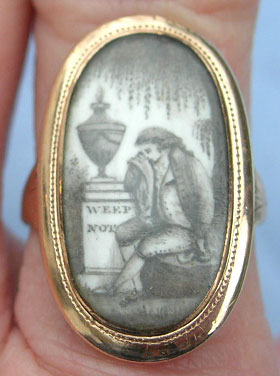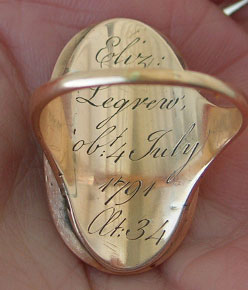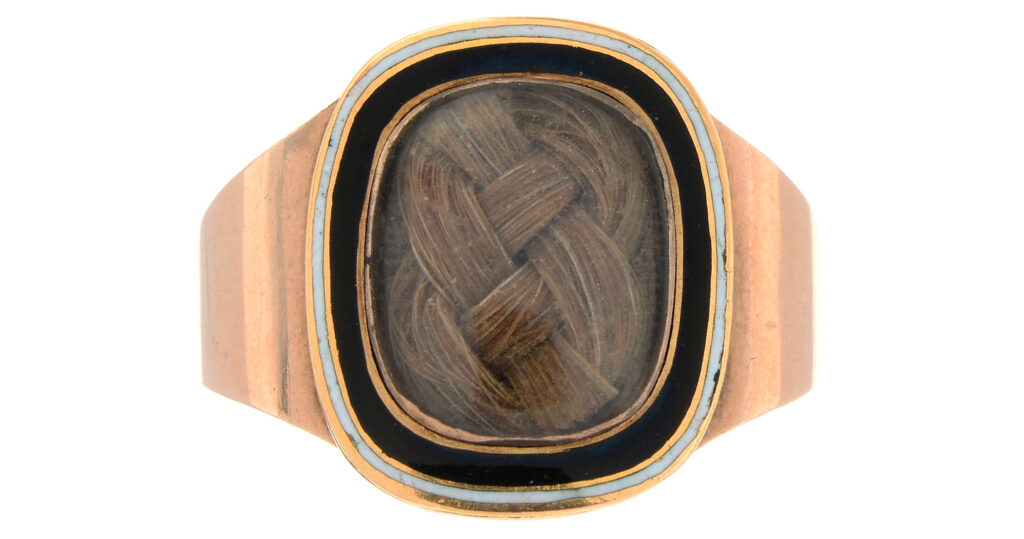Eliz Legrew Ob 4th July 1791 AE 34 / Sepia Male Mourning Ring
The male in mourning rings of the late 18th century and the Neoclassical period is a rare and important symbol, as it can tell us much about the jewel with which it is placed.
The woman, being the idealised romantic and symbolic centre of mourning for the family and the individual who would be wearing the jewels depicting grief, is the most standard mourning character of the time. Often wearing the white Neoclassical mourning attire, she is often standing or sitting next to a tomb or plinth, flanked with symbols of death and surrounded by the weeping willow. Often, these pieces were pre-created and sold with minor customisations to the person who acquired them, others, however, are of a higher quality and are purely commissioned for the person in mourning. These can be seen for their differences within the mourner herself; faces and costumes can often reflect the wearer and the jewel is almost a portrait, capturing the individual in a Neoclassical setting and depicting their grief.
While many miniature portraits of the time were created with a Neoclassical ideal and many facial features were standardised (eyes being an important one), the male in mourning depictions is too small within the jewel to standardise and not prolific enough to create many of, then sell them for a profit. The gentleman is often wearing the fashion of the day, the hairstyle would be that of the person who was wearing it and the more minute features would be accommodated by the miniaturist.
With this jewel, we have the larger oval shape, something which was necessary for the expansion of mounting depictions of the time on ivory, from the narrower navette shapes of the 1780s. This particular jewel is a little more customised for its depiction, so its shape is rather more grand than that of contemporary pieces.
The scene of the gentleman beneath the willow and the plinth are designed in tandem. We have the larger willow hanging lower than many concurrent pieces (where the willow would flank the border of the ring) and notice the lettering of ‘WEEP NOT’ – it’s designed around the leg of the gentleman, rather than being intersected. The wider urn is on display here, slightly to the left of the centre of the plinth, putting the focus on the gentleman. This is important, as often the urn would be the centre of the piece, making the reason for its being the person who was passed, but this ring seems to put the emphasis on the gentleman himself. The gentleman, as well as wearing the piece to show his grief, is depicting himself within himself to be in mourning, which seems to deflect the focus away from the Elizabeth Legrew.
It’s interesting to note that the period of 1790 saw the height of the Neoclassical sepia and mourning depictions with the highest degree of variance. In ‘A Navette Sepia Hairwork Ring‘ and ‘A Father’s Grief in a Ring From 1796′ there are two different styles, all within roughly the same period of time. Location and fluctuating styles had much to do with the kind of a jewel that was produced for its time; you’ll note in mourning jewellery that the customs, visual preference and style can be completely different from city to city.
What is important to note is that the reason for these jewels fit well into their time. The male’s input into fashion was higher than the Victorian period would ever be and this late 18th to early 19th century fashion let the humanist approach manifest itself within what people could wear and present themselves to the public. The male, in these cases, could show their emotion through what they wore and what they wore was still opulent and beautiful.
Further Reading
> A Father’s Grief in a Ring From 1796
> Symbolism Sunday, The Male
> A Navette Sepia Hairwork Ring
> For He’s a Jolly Good Fellow
> Knowing Your Fashion, Mourning Fashion in the 17th-19th Centuries








